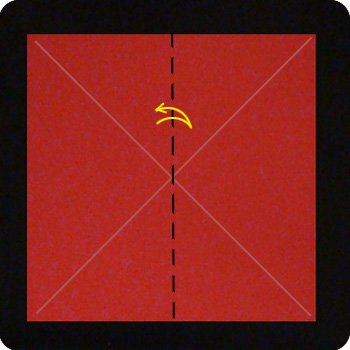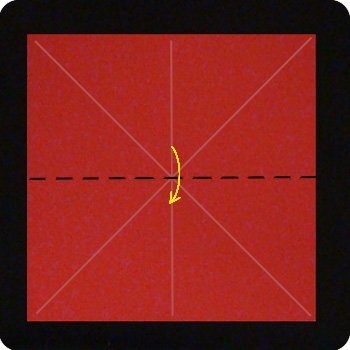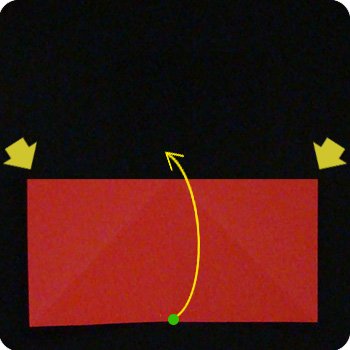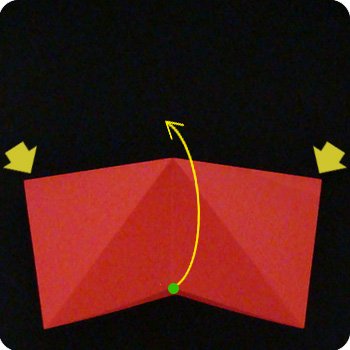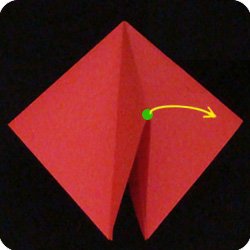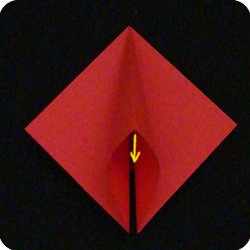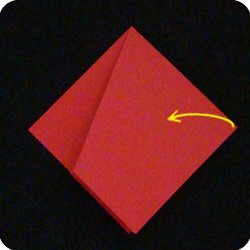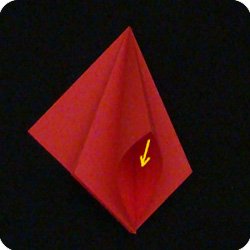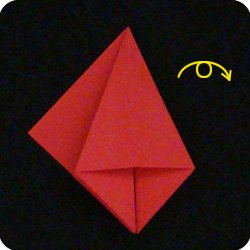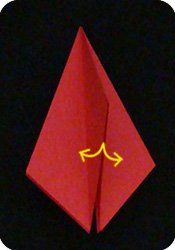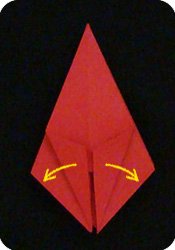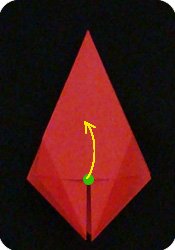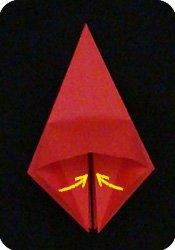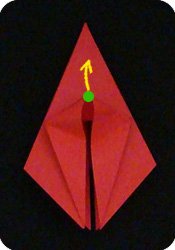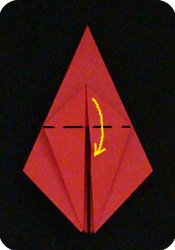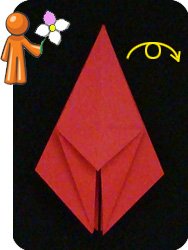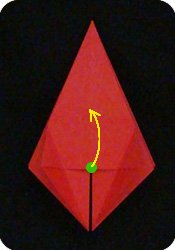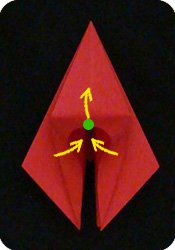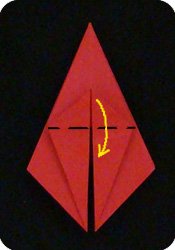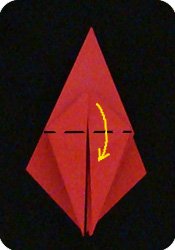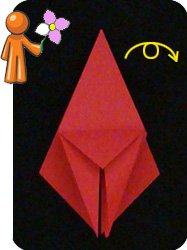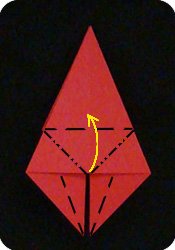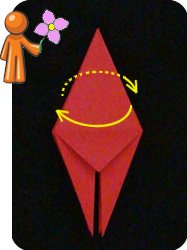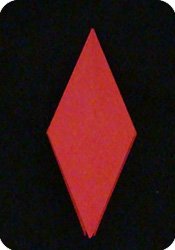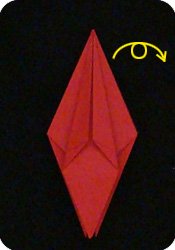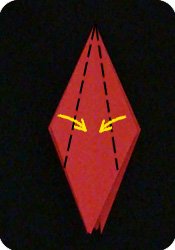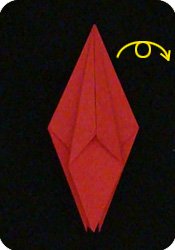
The origami iris (also called an origami lily) is a traditional design loved by many. The folding sequence is considered “intermediate” in difficulty. It is not a hard model to make, but there are quite a few steps to follow. Many of the steps are repeat-on-the-other-side types of fold. Because there are so many repeated folds, it can get confusing. The thing to remember with this origami iris is that there are 4 petals, so the folding sequences need to be done 4 times. If you find this model too difficult to complete, try the day lily which is easier and looks quite similar.
Shown on the right are three origami iris flowers. They are all made the same way, the only difference is how much the petals are rolled back.
• The yellow flower has petals which are just slightly pulled back.
• The blue flower has flared petals, only the tips are curled back.
• The red origami iris flower has petals which are curled the most.
Instructions for Traditional Origami Iris (Lily)

Step 1:
Start with a square sheet: fold and unfold the paper along the diagonals (in both directions). This gives you an “X” shaped crease. In this example, the paper is the same color on both sides. If you are using paper which is white on the back side, then start with the colored-side facing up. |
|
Step 2:
Turn the paper over. |
|
Step 3:
Fold the paper in half (top to bottom). |
|
Step 4:
Gently push the top-left and top-right corners of the paper towards each other. The top layer of paper will lift up along the pre-made creases. |
|
Keep pushing the corners together. |
|
Watch the movement of the green dot. |
|
Step 5
Swivel the flap of paper towards the right. There should be a similar flap of paper behind the model. Swivel this back flap towards the left. When done (see next photo), you will get a square shaped piece of paper that is a quarter of the size of the original paper. This form is called a “Preliminary Base” and it is commonly used in the making of many origami models. |

Step 6:
We will make a “squash fold”. First, lift the right-flap of paper back up towards you. |
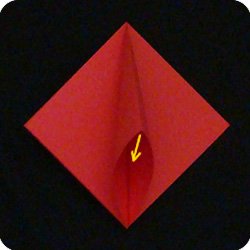 Pry open the two layers of paper and press down (squash the paper flat). |
 This is how it should look like. Turn the model over. |
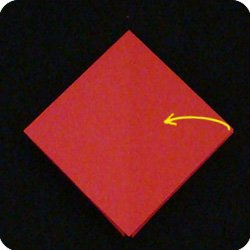
Step 7:
Repeat the squash fold. First, lift up the right-flap. |

Note: If you used paper that is white on one side and colored on the other side, the model would look more like the one on the left. Some of the white is showing. |
|
|
|
Step 8:
Like turning the pages of a book, swivel the squashed-flap from the right towards the left. |
|
Step 9:
Time to do the third squash: lift the right-flap up. |
|
|
|
Step 10:
This is how the model should look like. Turn the model over. |
|
Step 11:
Perform the final squash fold: lift the right-flap…. |
|
Step 12:
…pry open the layers and squash the paper down. |

Step 13:
Now we start the four “Petal Folds”. |
|
|
|
|
|
|
|
|
|
|
|
Step 14:
This is the completed “petal fold”. You will need to do this three more times for the other three petals. |
|
Step 15:
Fold the bottom-left and bottom-right edges of the paper towards the vertical midline as shown. |
|
|
|
|
|
|
|
|
|
Step 16:
Like turning the pages of a book, turn two flaps from the right towards the left. |
|
Step 18:
Time for the third petal fold: fold and unfold the bottom-left and bottom-right edges of the paper towards the central midline. |
|
|
|
|
|
|
|
Step 18:
Note the abbreviated way of showing the petal fold. Not all steps are shown |
|
Step 19:
Like turning pages in a book: swivel one flap of paper from the right towards the left. At the back of the model, swivel one layer from right to left. |
|
|
|
|
|
Step 20:
Turn the model over. |
|
|
|
|
|
Step 21:
Repeat: fold the top-left and top-right edges to the center. |
|
|
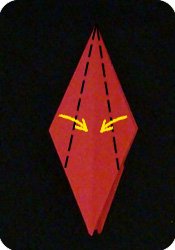 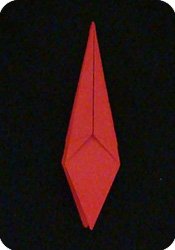
Step 22:
For the last time: fold top-left and top-right edges to the center. |
  Time to curl the petals. Wrap the bottom flaps of paper around a pencil to curl the petals. |
 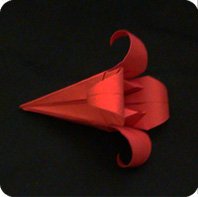 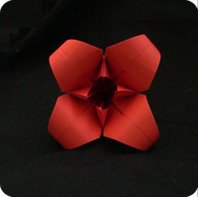 Top and side views. |

Watch video:
